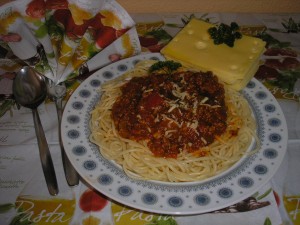My Take on the History of Bavarian Food.
Article 3 of 4, starting with “What is German Cooking” and followed by article 4 “The Bayrische Küche – Bavarian Cuisine”In this article I will give my explanation of how, what we call “Bayrische Küche” (Bavarian cuisine) came together.
Going back a long, long time people all over lived off the land and their diet reflected 100% what was locally available. Through wars and foreign occupation the peoples from the different regions were introduced to the foods of their conquerors, like the Roman’s influence in southern Bavaria , the Franken King Karl der Grosse, (Carl the Great) also known as Charlemagne. Much later even Napoleons armies, during their occupation of large parts of Europe, influenced everything from the way of life, the food and even the language.
 We could ponder here if the Romans actually introduced Spaghetti and Meatballs to the areas they occupied, but then there is still the rumor that Marco Polo brought the noodle recipe back from China long after the Romans were gone. Although being close to retirement, I was not there during that time and can not knowingly comment on it. I don’t even know when the Swabian counterpart “the Spaetzle” was invented.
We could ponder here if the Romans actually introduced Spaghetti and Meatballs to the areas they occupied, but then there is still the rumor that Marco Polo brought the noodle recipe back from China long after the Romans were gone. Although being close to retirement, I was not there during that time and can not knowingly comment on it. I don’t even know when the Swabian counterpart “the Spaetzle” was invented.
One thing for sure is that the influences of all these foreigners, called “Zug’reiste” by the locals (*see below), had a very influential part in Bavarian cuisine. Alone the “Böfflamot” (Boeuf a la mode) points to the French influence under Napoleon. Other influences came from the marriage of, let’s say, a Bavarian Duke to a Spanish Countess and her instructions to the head cook to prepare some dishes she was familiar with and the trickle down effects of these recipes to the local population and their inclusion into the repertoire of local dishes.
Others specialties came together from the need of the hostess/cook of a local guest house to use up some Brie cheese which was already overripe, because of a stupid remark from a costumer (**, see below) or just out of necessity of the common folks to keep their treasured food from spoiling.
Early on the spices used, like Caraway, Mustard, Mugwort and even Woodruff (used to spice “Maiwein”), were from local sources. During the Roman times the southern spice selections were brought over the Alps and the Trading Merchant Caravans in the Middle Ages introduced many new tastes and also other things during the “Jahrmarkt”, the annual market day which is still a popular and well attended local festival in towns all over Germany today.
This brings us to “The Bayrische Küche – Bavarian Cuisine” in the next article
* “Zug’reiste” – German from “zu-reisen” could be loosely translated with “traveled there and stayed “or “not born in the area”.
** = refers to the story of a customer’s remark at a local pub: “I could eat this sausage by the meter”, the host went to make a sausage a meter long and served it to the customer, with this the “Meterbratwurst” in the River Main area was born.

